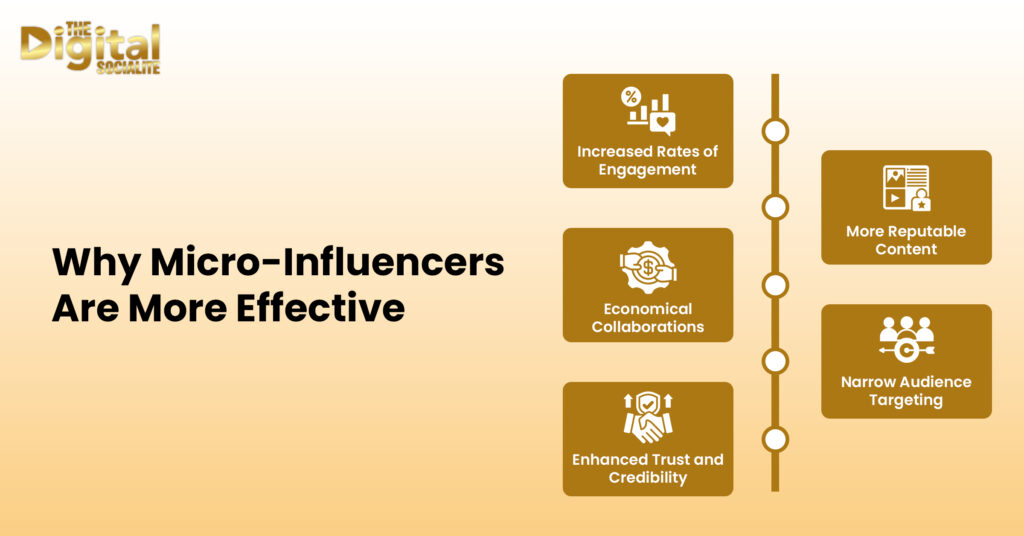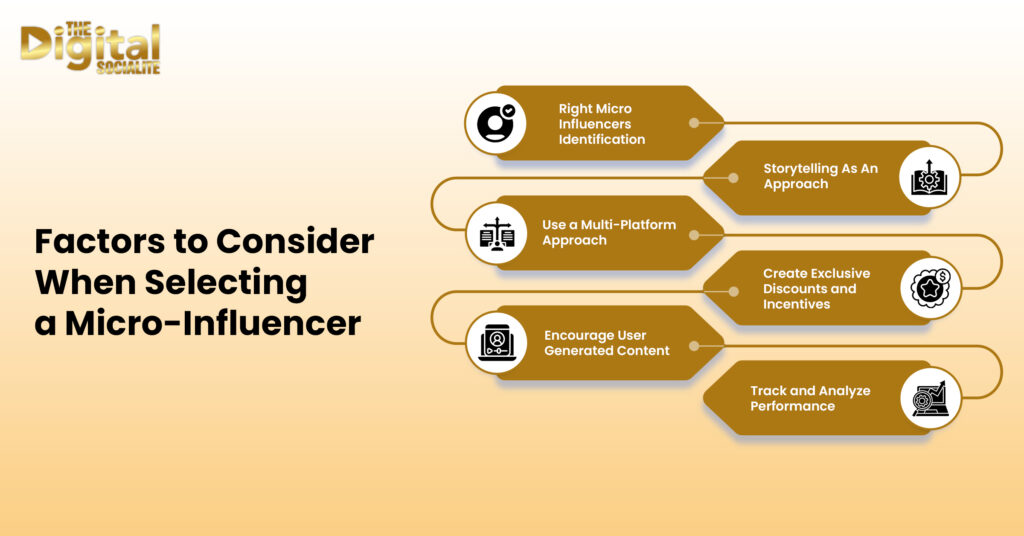Influencer marketing has made dramatic changes in the past ten years. From mostly celebrity endorsements, brands are now quickly transitioning to micro-influencer marketing for engagement and building real connections. It is not the A-list celebrities who would be in the limelight anymore; with smaller yet super-module audiences, it’s going to be a micro-influencer that offers more ways and better cost-effective product marketing for brands.
In this article, we will motivate you on the reasons, return benefits of better usage, and maximizing impact about why micro-influencers are taking hold. This guide will make you understand why micro-influencers are the next big thing in industry influence strategy for brands.
Who Are Micro-Influencers?
What constitutes micro-influencers and their range? Micro-influencers refer to individuals with followers that range from 1,000-100,000. They are more niche in their topics, interests, industry or community than traditional CELEBRITIES and MEGA-INFLUENCERS. Whether beauty, fitness, technology reviewing, or fashion blogging, they have made themselves trusted because of their expertise and authenticity within that niche.
Reasons Why Micro-Influencers Are More Effective Than Celebrities
The first one is generally economical. Eventually, the number of followers they follow decides that they have a relationship.

1. Increased Rates of Engagement
Micro-influencers tend to build stronger ties between the micro-influencers and their followers. Because the Micro-influencers have a smaller audience, they are able to offer better connections through comments, direct messages, and live sessions. In comparison to celebrity influencers with an audience of millions where only a few interact, these connections lead to much higher engagement.
2. More Reputable Content
People have learned that they prefer raw authenticity to shiny, well-scripted promotion. Micro-influencer submissions feel much more personal and relatable; thus, their sponsored product endorsement is much more powerful. Instead of forcing products for pay, they build relations and bonds with people to refer to things they use and trust.
3. Economical Collaborations
Endorsement by a celebrity involves an expensive cash outflow of thousands or millions of dollars. A micro-influencer charges a few bucks for the same work but yields amazing results, making it a great option for small and medium-sized businesses that want to do more with their marketing budgets.
4. Narrow Audience Targeting
When celebrities partner with a brand, they reach millions with their promotion, but by now only a minor proportion may be interested in the actual product. Conversely, niche influencer campaigns focus on segments within the marketplace, already ensuring that the audience is seeking the product or service. The conversion would be better with an approach such as this in use.
5. Enhanced Trust and Credibility
Micro-influencers flourish on the assumption of everyday people; that they are not gods or goddesses of unattainable celebrity stature. Their audience perceives these micro-influencers as friends or experts in their domains, thereby building trust. A product endorsement by them is then considered a true recommendation, not just a paid advertisement, by the followers.
Micro-Influencers Generate Better Returns
Any marketing strategy deserves an appropriate evaluation on the basis of return on investment (ROI). The brands, however, do find influencer ROI greater when it is micro-influencer versus celebrity. The reason is as follows:
1. Better Conversions
Studies show that micro-influencers have a better conversion rate since their crowds are highly engaged and loyal. So, when a micro-influencer speaks about a product, the audience is likely to purchase it.
2. Authentic Brand Endorsement
Celebrity endorsements often comprise many brands at the same time, whereas micro-influencers tend to endorse a few. This selective endorsement makes their recommendations believable and, thus, the sales are high and the brand’s loyalty is strong.
3. Greater Organic Reach
The algorithms of social platforms like Instagram, TikTok and YouTube reward engagement-driven content. When micro influencers post their audience’s most engaging relatable content, they generate higher likes, comments and shares that provide visibility to them organically.
4. Many Versus One Micro Influencer From Going Celebrity
Instead of a single celebrity, brands would maximize their strategy using many micro-influencers from different locations and different demographics. This would not only achieve a broader reach and engagement but would also reduce the risk to investment.
Factors to Consider When Selecting a Micro-Influencer:
A strong influencer marketing strategy would cultivate the best collaboration. This is a step-by-step miracle guide to maximizing the result of your campaign:

1. Right Micro-Influencers Identification
This will be the be-all and end-all foundation for your influencer marketing campaign. Not every influencer will match perfectly with your brand, thus it is necessary to evaluate their audience, content style, and values.
- Engagement Rate: Look beyond follower counts. Micro-influencers will generally have higher engagement rates because their followers believe in their opinions. Engagement can be gauged by likes, comments, shares and other interactions
- Content Quality and Consistency: Past content ensures that the influencer’s message aligns with your message. Authenticity and creativity play a big part.
- Audience Demographics: The followers of the influencer are needed with reference to age, location, gender, and interests. They should be in line with your target audience.
- Previous Brand Collaborations: Also check whether the influencer has previously worked with competitors or brands within the same category. How did they promote the past product? Was their content very effective?
These influencer marketing portals like AspireIQ, Upfluence, or Heepsy can help brands identify the identified suitable micro-influencers based on such criteria.
2. Storytelling As An Approach
One of the mistakes brands make when dealing with influencers is seeing influencer marketing in the same light as classic advertising. Today’s consumers are as resistant as ever to overly promotional content. Instead of a truly strict script, let the influencer use your brand within their style of telling the story.
Why is storytelling vital for influencer marketing?
- Authenticity: Followers engage more with genuine experiences rather than something forced.
- Emotional Connection: A well-told story can make a brand more relatable and memorable.
- Conversion: Storytelling-influenced content generally garners greater interaction, and hence visibility and conversion.
Best Storytelling Approaches for Influencer Marketing:
- Personal Experience: Have her provide her own experience of how the product worked for her as an influencer.
- Behind the Scenes: Let them take their audience into an inside look at how you manufacture your product or how it fits into their routine.
- Challenges and Testimonials of Users: You can hold an influencer plus followers together’s challenge with regard to your Brand.
For example: If it is a skincare product that has launched a new moisturizer, an influencer could shoot a video on their experience of 7 days applying the product instead of saying “benefits of their moisturizer”.
3. Use a Multi-Platform Approach
Micro-influencers are active on Instagram, YouTube, TikTok, and Twitter; rather than limiting campaigns to a single platform, diversify into as many channels as possible to widen exposure.
4. Create Exclusive Discounts and Incentives
Offering influencers discount codes or time-limited promotions will drive their audience to action. It also offers opportunities for brands to measure how successful a campaign has been and figure out ROI.
5. Encourage User-Generated Content
Micro-influencers boost their followers to make content about your brand. Give motivation in the form of branded hashtags, challenges, or their own experiences with your product. This doesn’t just optimize the reach of the campaign but also moves towards community-building around your brand.
6. Track and Analyze Performance
Evaluating the success of campaigns is important for strategy optimization in the future. The KPIs measured include the following:
- Engagement metrics: likes, comments, and shares on posts
- Click-through rates: Individuals clicking on a given URL
- Conversion rates: sale or sign-ups
- Return on Investment Analysis
Collect data and refine future campaigns using social media analytics tools and influencer marketing platforms.
Successful Brand Examples Using Micro-Influencer Marketing
Numerous brands have significantly benefited from the use of influencer marketing; below are some real-world examples:
1. Daniel Wellington
The watch brand Daniel Wellington became popular by collaborating with micro-influencers from different corners of the world instead of big celebrity endorsements. Rather, they had everyday fashion influencers wear their watches in real-life lifestyle settings. The result was a massive sales surge and brand recognition.
2. Glossier
The beauty brand Glossier manages to thrive primarily through user-generated content paired up with micro-influencer marketing. Working with small beauty bloggers and skin-care enthusiasts, the picture is that they have sculpted the community into a cult group of brand advocates who bring their message out by really promoting it themselves without advertising much.
3. Gymshark
Gymshark, a fitness apparel brand, depends much on micro-influencers and fitness enthusiasts, as far as advertising via this medium goes, instead of dependably hiring high-profile athletes. With high-profile athletes, Gymshark would de-emphasize engaging more with grassroots types of brands, promoting their products using lesser-known fitness enthusiasts rather than big-star athletes or a limited number of people, targeting instead those whose communities are really involved in fitness.
Conclusion
The move has shifted from celebrity endorsements to influencer marketing in this digital age of new forms of advertising. Through micro-influencer campaigns, brands will achieve high engagement as well as an improved roar of influence against total cost.
An effective influencer marketing strategy can help businesses save costs by creating the right approach for marketing to a particular audience while nurturing long-term consumer engagement. Whether serving new or established brands, micro-influencer marketing stands to differentiate businesses from the rest in the modern digital space.





